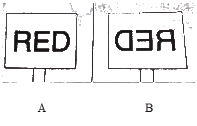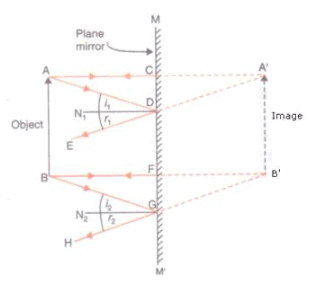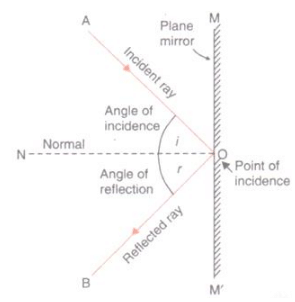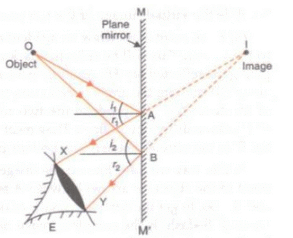Lakhmir Singh & Manjit Kaur: Reflection of Light, Solutions- 1 | Science Class 10 PDF Download
Page No:173
Question 1: What happens when a ray of light falls normally (or perpendicularly) on the surface of a plane mirror ?
Solution : As ray of light falls normally on mirror, this means that angle of incidence is 0o. From second law of reflection, we know that angle of incidence is equal to angle of reflection. So, angle of reflection will also be zero. Therefore, the light ray will be reflected back along the same path.
Question 2: A ray of light is incident on a plane mirror at an angle of 30°. What is the angle of reflection ?
Solution : According to the second law of reflection, angle of incidence is equal to the angle of reflection.
Therefore, angle of reflection=300
Question 3: A ray of light strikes a plane mirror at an angle of 40° to the mirror surface. What will be the angle of reflection ?
Solution : Angle to the mirror surface = 400
Therefore, angle of incidence = 900-400 = 500
According to the second law of reflection, angle of incidence is equal to the angle of reflection.
Therefore, angle of reflection = 500
Question 4: A ray of light is incident normally on a plane mirror. What will be the :
(a) angle of incidence ?
(b) angle of reflection ?
Solution :
(a) 00
(b) 00
Question 5: What type of image is formed :
(a) in a plane mirror ?
(b) on a cinema screen ?
Solution : (a) Virtual image
(b) Real image
Question 6: What kind of mirror is required for obtaining a virtual image of the same size as the object ?
Solution : Plane mirror.
Question 7: What is the name of the phenomenon in which the right side of an object appears to be the left side of the image in a plane mirror ?
Solution : Lateral inversion.
Question 8: Name the phenomenon responsible for the following effect:
When we sit in front of a plane mirror and write with our right hand, it appears in the mirror that we are writing with the left hand.
Solution : Lateral inversion.
Question 9: If an object is placed at a distance of 10 cm in from of a plane mirror, how far would it be from its image ?
Solution : The image is formed behind the mirror at the same distance as the object is kept in front of the mirror.
Given distance between object and mirror=10cm.
Distance between mirror and image=10cm.
Therefore, the distance between object and image=10+10=20cm.
Question 10: Which property of light makes a pencil cast a shadow when it is held in front of a light source ?
Solution : Light travels in straight lines.
Question 11: The image seen in a plane mirror cannot be formed on a screen. What name is given to this type of image ?
Solution : Virtual image.
Question 12: Fill in the following blank with a suitable word :
When light is reflected, the angles of incidence and reflection are…………
Solution : Equal.
Question 13: State whether the following statement is true or false :
A student says that we can see an object because light from our eyes is reflected back by the object.
Solution : False.
Question 14: Where is the image when you look at something in a mirror ?
Solution : At the back side of mirror.
Question 15: A ray of light strikes a plane mirror such that its angle of incidence is 30°. What angle does the reflected ray make with the mirror surface ?
Solution : According to the second law of reflection, angle of incidence is equal to the angle of reflection.
Given angle of incidence=300
Therefore, angle of reflection=300
Angle made by the reflected ray with mirror surface=900-300=600
Question 16: What is the difference between a real image and a virtual image ? Give one example of each type of image.
Solution : Real image can be obtained on a screen because light rays actually pass through a real image but virtual image cannot be formed on screen because light rays do not actually pass through a virtual image.
Example:-
The image formed on a cinema screen is an example of real image.
The image formed by a plane mirror is a virtual image.
Question 17: The letter F is placed in front of a plane mirror :
How would its image look like when seen in a plane mirror ?
What is the name of the phenomenon involved ?
Solution : 
(b) Lateral inversion
Question 18: What is lateral inversion ? Explain by giving a suitable example.
Solution : When an object is placed in front of a plane mirror, then the right side of the object appears to become the left side of the image; and the left side of the object appears to become right side of the image. This change of the sides of an object and its mirror image is called lateral inversion.
Ex. When we hold a placard having the word RED written on it, as given in fig A, in the front of a plane mirror, the image of the word RED will be as given in fig B.

Question 19: Write the word AMBULANCE as it would appear when reflected in a plane mirror. Why is it sometimes written in this way (as its mirror image) on the front of an ambulance ?
Solution : 
Because while driving our car. If we see In our rear-view mirror that the hospital van Is coming from behind, then we wiilget the laterally inverted image of  and read it as AMBULANCE and give way for it to pass through.
and read it as AMBULANCE and give way for it to pass through.
Question 20: What are the important differences between looking at a photograph of your face and looking at yourself in a plane mirror ?
Solution : A image of our face in a plane mirror is laterally inverted, so left is right and right is left. However, in a photograph of our face this is not the case.
Page No:174
Question 21: (a) A wall reflects light and a mirror also reflects light. What difference is there in the way they reflect light ?
(b) Which type of reflection of light leads to the formation of images ?
Solution : (a) A wall has a rough surface, so the reflection by a wall is a diffuse reflection. A parallel beam of light incident on it is reflected in different directions.
A mirror surface is smooth, so the reflection by a mirror is a regular reflection. A parallel beam of light incident on it, gets scattered by making reflected rays in different directions.
(b) Regular reflection
Question 22: What is the difference between regular reflection of light and diffuse reflection of light ? What type of reflection of light takes place from :
(a) a cinema screen (b) a plane mirror (c) a cardboard (d) still water surface of a lake
Solution : In regular reflection, a parallel beam of incident light is reflected as a parallel beam in one direction; while in diffuse reflection, a parallel beam of incident light is reflected in different directions.
(a) Regular reflection
(b) Regular reflection
(c) Diffuse reflection
(d) Regular reflection
Question 23: What can you see in a completely dark room ? If you switch on an electric bulb in this dark room as a light source, explain how you could now see :
(a) the electric bulb.
(b) a piece of white paper.
Solution : When we see in a completely dark room, we are not able to see anything because there is no light in the dark room.
(a) We can see bulb due to the light emitted by the bulb.
(b) We can see a piece of white paper because it reflects the light from the bulb falling on it.
Question 24: (a) A boy with a mouth 5 cm wide stands 2 m away from a plane mirror. Where is his image and how wide is the image of his mouth ?
(b) The boy walks towards the mirror at a speed of 1 m/s. At what speed does his image approach him ?
Solution : (a) The image will form 2 m behind the mirror and the width of the image of boy’s mouth will be 5 cm.
(b) When the boy walks towards the mirror at a speed of 1 m/s, his image will also appear to move towards the mirror at the same speed of 1 m/s. So, the speed at which his image approach him will be 2 m/s + 2 m/s = 4 m/s.
Question 25: (a) An extended object in the form of an arrow pointing upward has been placed in front of a plane mirror. Draw a labelled ray-diagram to show the formation of its image.
(b) State the uses of plane mirrors.
Solution :

(b) Uses of Plane mirrors:
(i) Plane mirrors are used to see ourselves. The mirrors on our dressing table and in bathrooms are plane mirrors.
(ii) Plane mirrors are fitted at blind turns of some busy roads so that drivers can see the vehicles coming from the other side and prevent accidents.
(iii) Plane mirrors are used to make periscopes.
(iv) Plane mirrors are fixed on the inside walls of certain shops to make them look bigger.
Question 26: What is meant by ‘reflection of light’ ? Define the following terms used in the study of reflection of light by drawing a labelled ray-diagram :
(a) Incident ray
(b) Point of incidence
(c) Normal
(d) Reflected ray
(e) Angle of incidence
(f) Angle of reflection
Solution : The process of sending back the light rays which fall on the surface of an object is called reflection of light.

(a) Incident ray: The ray of light that falls on the mirror surface is called the incident ray.
(b) Point of incidence: The point at which the incident ray falls on the mirror is called the point of incidence.
(c) Normal: The normal is a line at right angle to the mirror surface at the point of incidence.
(d) Reflected ray: The ray of light which is sent back by the mirror is called the reflected rays.
(e) Angle of incidence: The angle of incidence is the angle made by the incident ray with the normal at the point of incidence.
(f) Angle of reflection: The angle of reflection is the angle made by the reflected ray with the normal at the point of incidence.
Question 27: State and explain the laws of reflection of light at a plane surface (like a plane mirror), with the help of a labelled ray-diagram. Mark the angles of ‘incidence’ and ‘reflection’ clearly on the diagram. If the angle of reflection is 47.5°, what will be the angle of incidence ?
Solution : Laws of reflection of light:

First law of reflection: According to the first law of reflection, the incidence ray, the reflected ray and the normal (at the point of incidence), all lie in the same plane. For e.g., in the figure, the incident ray AO, the reflected ray OB and the normal ON, all lie in the same plane, the plane of paper.
Second law of reflection: According to the second law of reflection, the angle of reflection is always equal to the angle of incidence. For e.g., if we measure the angle of reflection NOB in the figure, we will find that it is exactly equal to the angle of incidence AON.
If the angle of reflection is 47.5o, the angle of incidence will also be 47.5o in accordance with the second law of reflection.
Question 28: With the help of a labelled ray-diagram, describe how a plane mirror forms an image of a point source of light placed in front of it. State the characteristics of the image formed in a plane mirror.
Solution :

Cosider a point source of light O placed in front of a plane mirror MM’. a ray of light OA coming from O in incident at point A on the mirror and gets reflected in the direction AX according to the laws of reflection of light. Another ray of light OB coming from O strikes the mirror ar point B and gets reflected in the direction BY. Rays AX and BY, on producing backwards, meet at point I behind the mirror; which is the image of point source O.
Characteristics of image formed in a plane mirror:
(i) The image formed in a plane mirror is virtual. It cannot be received on a screen.
(ii) The image formed in a plane mirror is erect. It is the same side up as the object.
(iii) The image in a plane mirror is of the same size as the object.
(iv) The image formed by a plane mirror is at the same distance behind the mirror as the object is in front of the mirror.
(v) The image formed by a plane mirror is laterally inverted.
Question 29: (a) Explain why, though both a plane mirror and a sheet of paper reflect light but we can see the image of our face in a plane mirror but not in a sheet of paper.
(b) The image in a plane mirror is virtual and laterally inverted. What does this statement mean ?
(c) Write all the capital letters of the alphabet which look the same in a plane mirror.
Solution : (a) We can see the image of our face in a plane mirror but not in a sheet of paper because images are formed by regular reflection of light and in case of a plane mirror, regular reflection takes place; while in case of a sheet of paper, diffuse reflection takes place.
(b) The image is virtual and laterally inverted means it cannot be obtained on a screen and is reversed sideways.
(c) A, H, I, M, O
|
80 videos|569 docs|80 tests
|
FAQs on Lakhmir Singh & Manjit Kaur: Reflection of Light, Solutions- 1 - Science Class 10
| 1. What is the reflection of light? |  |
| 2. How does reflection of light occur? |  |
| 3. What are the types of reflection of light? |  |
| 4. How does a mirror produce an image? |  |
| 5. What is the difference between concave and convex mirrors? |  |

















